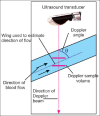General principles of image optimization in EUS
- PMID: 33666178
- PMCID: PMC8248305
- DOI: 10.4103/eus.eus_80_20
General principles of image optimization in EUS
Abstract
With the development of modern EUS, multiple imaging functions, transducer settings, and examination modes have become available for clinical settings. While the major determinants of the ultrasound beam are still comprised of the signal wavelength, its frequency range, and its amplitude, other modifications and calculations have gained more interest for advanced users, such as tissue harmonic imaging (THI), spatial and frequency compounding, certain versions of speckle reduction, and various Doppler/duplex settings. The goal of such techniques is a better, perhaps more realistic image, with reduced artifacts (such as speckle), better image contrast, and an improved signal-to-noise ratio. In addition, "add-ons" such as THI, which is based on the phenomenon of nonlinear distortion of acoustic signals as they travel through tissues, provide greater contrast and an enhanced spatial resolution than conventional EUS. Finally, optimization of spectral and color Doppler imaging in EUS requires experience and knowledge about the basic principles of Doppler/duplex phenomena. For these purposes, factors such as adjustment of Doppler controls, Doppler angle, color gain, spectral wall filters, and others require special attention during EUS examinations. Incorporating these advanced techniques in EUS examinations may be time-consuming and cumbersome. Hence, practical guidelines enabling endosonographers to steer safely through the large quantity of technological properties and settings (knobology) are appreciated. This review provides an overview of the role of important imaging features to be adjusted before, during, and after EUS procedures.
Keywords: B-mode; EUS; doppler; guideline; image quality.
Conflict of interest statement
None
Figures





























Similar articles
-
Breast ultrasound knobology and the knobology of twinkling for marker detection.Transl Breast Cancer Res. 2024 Oct 29;5:28. doi: 10.21037/tbcr-24-30. eCollection 2024. Transl Breast Cancer Res. 2024. PMID: 39534581 Free PMC article. Review.
-
Current status of tissue harmonic imaging in endoscopic ultrasonography (EUS) and EUS-elastography in pancreatobiliary diseases.Dig Endosc. 2015 Apr;27 Suppl 1:68-73. doi: 10.1111/den.12433. Dig Endosc. 2015. PMID: 25630752 Review.
-
A novel perfusion imaging technique of the pancreas: contrast-enhanced harmonic EUS (with video).Gastrointest Endosc. 2008 Jan;67(1):141-50. doi: 10.1016/j.gie.2007.07.045. Gastrointest Endosc. 2008. PMID: 18155437
-
Contrast-enhanced harmonic color Doppler for left ventricular opacification: improved endocardial border definition compared to tissue harmonic imaging and optimization of methodologyin patients with suboptimal echocardiograms.Echocardiography. 2001 Nov;18(8):639-49. doi: 10.1046/j.1540-8175.2001.00639.x. Echocardiography. 2001. PMID: 11801205
-
Image quality evaluation of ultrasound imaging systems: advanced B-modes.J Appl Clin Med Phys. 2019 Mar;20(3):115-124. doi: 10.1002/acm2.12544. J Appl Clin Med Phys. 2019. PMID: 30861278 Free PMC article.
Cited by
-
Modern Management of Common Bile Duct Stones: Breakthroughs, Challenges, and Future Perspectives.Cureus. 2024 Dec 6;16(12):e75246. doi: 10.7759/cureus.75246. eCollection 2024 Dec. Cureus. 2024. PMID: 39776736 Free PMC article. Review.
-
Ultrasonographic Elastography of the Spleen for Diagnosing Neoplastic Myeloproliferation: Identifying the Most Promising Methods-A Systematic Review.J Clin Med. 2025 Jul 31;14(15):5400. doi: 10.3390/jcm14155400. J Clin Med. 2025. PMID: 40807021 Free PMC article. Review.
-
Secondary sclerosing cholangitis and IgG4-sclerosing cholangitis - A review of cholangiographic and ultrasound imaging.Endosc Ultrasound. 2023 Mar-Apr;12(2):181-199. doi: 10.4103/EUS-D-22-00208. Endosc Ultrasound. 2023. PMID: 36588352 Free PMC article. Review.
-
Basic Principles and Role of Endoscopic Ultrasound in Diagnosis and Differentiation of Pancreatic Cancer from Other Pancreatic Lesions: A Comprehensive Review of Endoscopic Ultrasound for Pancreatic Cancer.J Clin Med. 2024 Apr 28;13(9):2599. doi: 10.3390/jcm13092599. J Clin Med. 2024. PMID: 38731128 Free PMC article. Review.
References
-
- Dietrich CF, Bartsch L, Turco V, et al. Knöpfologie in der B-Bild-Sonografie. Gastroenterologie up 2date. 2018;14:347–64.
-
- Ishikawa H, Hirooka Y, Itoh A, et al. A comparison of image quality between tissue harmonic imaging and fundamental imaging with an electronic radial scanning echoendoscope in the diagnosis of pancreatic diseases. Gastrointest Endosc. 2003;57:931–6. - PubMed
-
- Ohno E, Kawashima H, Hashimoto S, et al. Current status of tissue harmonic imaging in endoscopic ultrasonography (EUS) and EUS-elastography in pancreatobiliary diseases. Dig Endosc. 2015;27(Suppl 1):68–73. - PubMed
-
- Bang JY, Hawes RH, Varadarajulu S. Objective evaluation of a new endoscopic ultrasound processor. Dig Endosc. 2013;25:554–5. - PubMed
LinkOut - more resources
Full Text Sources
Other Literature Sources

